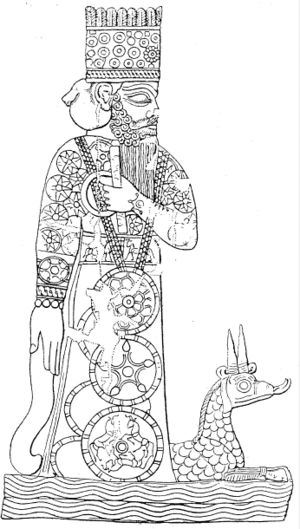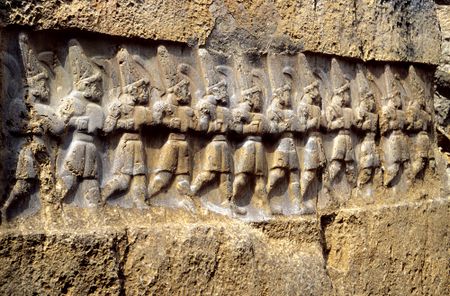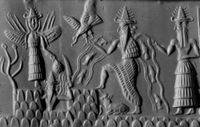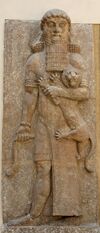أنـّوناكي
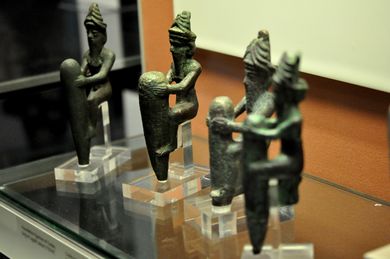
أنـّوناكي (بالسومرية: 𒀭𒀀𒉣𒈾 ، وتُكتب أيضاً أنـّوناو أنـّاناكي)، هم مجموعة من الآلهة في التقاليد الأسطورية السومرية، الأكادية، الآشورية والبابلية القديمة.[2] وصف عدد الأنـّوناكي والدور الذي كانوا يلعبونه غير متسق وغالباً ما يكون متناقض. في أقدم الكتابات السومرية عن الأنـّوناكي، والتي جاءت من الفترة ما بعد الأكادية، كان الأنـّوناكي هم أكثر الآلهة قوة في الپانثون، وينحدرون من أن، إله السماء وإلهة الأرض، وكانت وظيفتهم الأساسية هي تقرير أقدار البشرية. ويجب ألا يُخلط بينهم وبين أپكالو.
التسمية
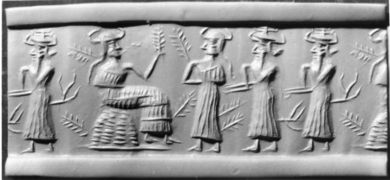
The name Anunnaki is derived from An,[4] the Sumerian god of the sky.[4] The name is variously written "da-nuna", "da-nuna-ke4-ne", or "da-nun-na", meaning "princely offspring" or "offspring of An".[2]
The Anunnaki were believed to be the offspring of An and his consort, the earth goddess Ki.[2] Samuel Noah Kramer identifies Ki with the Sumerian mother goddess Ninhursag, stating that they were originally the same figure.[5][6] The oldest of the Anunnaki was Enlil, the god of air[7] and chief god of the Sumerian pantheon.[8] The Sumerians believed that, until Enlil was born, heaven and earth were inseparable.[5] Then, Enlil split heaven and earth in two[5] and carried away the earth[5] while his father An carried away the sky.[5]
العبادة والتصوير
The Anunnaki are chiefly mentioned in literary texts[9] and very little evidence to support the existence of any cult of them has yet been unearthed.[9][10] This is likely due to the fact that each member of the Anunnaki had his or her own individual cult, separate from the others.[11] Similarly, no representations of the Anunnaki as a complete group have yet been discovered,[11] although a few depictions of two or three individual members together have been identified.[11] Deities in ancient Mesopotamia were almost exclusively anthropomorphic.[2] They were thought to possess extraordinary powers[2] and were often envisioned as being of tremendous physical size.[2] The deities typically wore melam, an ambiguous substance which "covered them in terrifying splendor".[2] Melam could also be worn by heroes, kings, giants, and even demons.[2] The effect that seeing a deity's melam has on a human is described as ni, a word for the physical tingling of the flesh.[2] Deities were almost always depicted wearing horned caps,[2][3] consisting of up to seven superimposed pairs of ox-horns.[2] They were also sometimes depicted wearing clothes with elaborate decorative gold and silver ornaments sewn into them.[3]
The ancient Mesopotamians believed that their deities lived in Heaven,[2] after an earlier history of visiting earth in the mythological texts, and that a god's statue was a physical embodiment of the god himself.[2][3] As such, cult statues were given constant care and attention[2][3] and a set of priests was assigned to tend to them.[3] These priests would clothe the statues[3] and place feasts before them so they could "eat".[2][3] A deity's temple was believed to be that deity's literal place of residence.[2] The gods had boats, full-sized barges which were normally stored inside their temples[2] and were used to transport their cult statues along waterways during various religious festivals.[2] The gods also had chariots, which were used for transporting their cult statues by land.[2] Sometimes a deity's cult statue would be transported to the location of a battle so that the deity could watch the battle unfold.[2] The major deities of the Mesopotamian pantheon, which included the Anunnaki, were believed to participate in the "assembly of the gods",[2] through which the gods made all of their decisions.[2] This assembly was seen as a divine counterpart to the semi-democratic legislative system that existed during the Third Dynasty of Ur (ح. 2112 BC–ح. 2004 BC).[2]
الأسطورة
السومرية
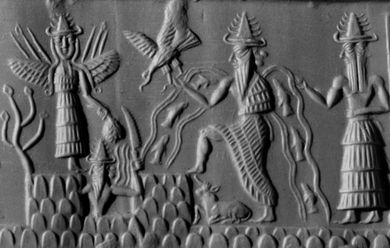
The earliest known usages of the term Anunnaki come from inscriptions written during the reign of Gudea (ح. 2144–2124 BC) and the Third Dynasty of Ur.[9][11] In the earliest texts, the term is applied to the most powerful and important deities in the Sumerian pantheon: the descendants of the sky-god An.[9][12]This group of deities probably included the "seven gods who decree":[6] An, Enlil, Enki, Ninhursag, Nanna, Utu, and Inanna.[6]
Although certain deities are described as members of the Anunnaki, no complete list of the names of all the Anunnaki has survived[11] and they are usually only referred to as a cohesive group in literary texts.[9][11] Furthermore, Sumerian texts describe the Anunnaki inconsistently[11] and do not agree on how many Anunnaki there were, or what their divine function was.[9][11] Originally, the Anunnaki appear to have been heavenly deities with immense powers.[11] In the poem Enki and the World Order, the Anunnaki "do homage" to Enki, sing hymns of praise in his honor, and "take up their dwellings" among the people of Sumer.[9][6] The same composition twice states that the Anunnaki "decree the fates of mankind".[9]
Virtually every major deity in the Sumerian pantheon was regarded as the patron of a specific city[3] and was expected to protect that city's interests.[3] The deity was believed to permanently reside within that city's temple.[3] One text mentions as many as fifty Anunnaki associated with the city of Eridu.[2][13] In Inanna's Descent into the Netherworld, there are only seven Anunnaki, who reside within the Underworld and serve as judges.[9][14] Inanna stands trial before them for her attempt to take over the Underworld;[9][14] they deem her guilty of hubris and condemn her to death.[14]
Major deities in Sumerian mythology were associated with specific celestial bodies.[3] Inanna was believed to be the planet Venus.[2][3] Utu was believed to be the sun.[3][2] Nanna was the moon.[3][2] An was identified with all the stars of the equatorial sky, Enlil with those of the northern sky, and Enki with those of the southern sky.[15] The path of Enlil's celestial orbit was a continuous, symmetrical circle around the north celestial pole,[16] but those of An and Enki were believed to intersect at various points.[16]
نص
حسب الأساطير السومرية، بدأ نشوء الكون من نمو، البحر الأول أو ماء العمق أو الإلهة الأولى.
بعد أن أبعدت السماء عن الأرض،
وبعد أن فُصلت الأرض عن السماء،
وبعد أن عين اسم الإنسان (خلق الإنسان)،
وبعد أن أخذ السماء «آن» (إله السماء)،
وبعد أن أخذ الأرض «إنليل» (إله الهواء)…»
خلقت نمو إله السماء آن، وإلهة الأرض كي، في هيئة جبلٍ متحدٍ يفصل بينهما ابنهما إنليل أو إله الهواء، الذي قام بإقصاء الأب آن إلى الأعلى فصار سماءنا، وانفرد الابن بأمه واتحد معها، فكان أبا الآلهة، ورب وملك السماء والأرض، ومن يبارك ملك البلاد، ويُتوّجه، ويُسلمه صولجانه، ويُخرج النهار والزرع، ويُغدق الخير والمال على العباد.
وفي الأرض هو عظيمها وكبيرها،
وبين الأنوناكي هو ربها العظيم»
لإنليل كذلك أخٌ غير شقيق يدعى الإله إنكي، سيد الحكمة والمطلع على ما تكنه الأفئدة، وصانع الإنسان من الطين من أجل خدمة الآلهة، كما يقترح المفكر والباحث السومري صاموئيل نوح.
الأكادية، البابلية والآشورية
| “ | Reverence begets favour, sacrifice prolongs life, and prayer atones for guilt. He who fears the gods is not slighted by [...] He who fears the Anunnaki extends [his days]. | ” |
—Babylonian hymn[17] | ||
الحرانية والحيثية
Akkadian texts of the second millennium BC follow similar portrayals of the Anunnaki from Inanna's Descent into the Netherworld, depicting them as chthonic Underworld deities. In an abbreviated Akkadian version of Inanna's Descent written in the early second millennium, Ereshkigal, the queen of the Underworld, comments that she "drink[s] water with the Anunnaki".[20] Later in the same poem, Ereshkigal orders her servant Namtar to fetch the Anunnaki from Egalgina,[20] to "decorate the threshold steps with coral",[20] and to "seat them on golden thrones".[20]
During the Old Babylonian Period (ح. 1830 BC – c. 1531 BC), a new set of deities known as the Igigi are introduced.[2] The relationship between the Anunnaki and the Igigi is unclear.[11] On some occasions, the categories appear to be used synonymously,[9][11] but in other writings, such as The Poem of Erra, there is a clear distinction between the two.[9][11] In the late Akkadian Atra-Hasis epic, the Igigi are the sixth generation of the gods who are forced to perform labor for the Anunnaki.[9][17] After forty days, the Igigi rebel and the god Enki, one of the Anunnaki, creates humans to replace them.[9][17]
From the Middle Babylonian Period (ح. 1592 – 1155 BC) onward, the name Anunnaki was applied generally to the deities of the underworld;[2] whereas the name Igigi was applied to the heavenly deities.[2] During this period, the underworld deities Damkina, Nergal, and Madānu are listed as the most powerful among the Anunnaki,[2] alongside Marduk, the national god of ancient Babylon.[2]
In the standard Akkadian Epic of Gilgamesh (ح. 1200 BC) Utnapishtim, the immortal survivor of the Great Flood, describes the Anunnaki as seven judges of the Underworld, who set the land aflame as the storm approaches.[20] Later, when the flood comes, Ishtar (the East Semitic equivalent to Inanna) and the Anunnaki mourn over the destruction of humanity.[9][20]
In the Babylonian Enûma Eliš, Marduk assigns the Anunnaki their positions.[21] A late Babylonian version of the epic mentions 600 Anunnaki of the underworld,[2] but only 300 Anunnaki of heaven,[2] indicating the existence of a complex underworld cosmology.[2] In gratitude, the Anunnaki, the "Great Gods", build Esagila, a "splendid" temple dedicated to Marduk, Ea, and Ellil.[21] In the eighth-century BC Poem of Erra, the Anunnaki are described as the brothers of the god Nergal[9] and are depicted as antagonistic towards humanity.[9]
A badly damaged text from the Neo-Assyrian Period (911 – 612 BC) describes Marduk leading his army of Anunnaki into the sacred city of Nippur and causing a disturbance.[18] The disturbance causes a flood,[18] which forces the resident gods of Nippur to take shelter in the Eshumesha temple to Ninurta.[18] Enlil is enraged at Marduk's transgression and orders the gods of Eshumesha to take Marduk and the other Anunnaki as prisoners.[18] The Anunnaki are captured,[18] but Marduk appoints his front-runner Mushteshirhablim to lead a revolt against the gods of Eshumesha[18] and sends his messenger Neretagmil to alert Nabu, the god of literacy.[18] When the Eshumesha gods hear Nabu speak, they come out of their temple to search for him.[18] Marduk defeats the Eshumesha gods and takes 360 of them as prisoners of war, including Enlil himself.[18] Enlil protests that the Eshumesha gods are innocent,[18] so Marduk puts them on trial before the Anunnaki.[18] The text ends with a warning from Damkianna (another name for Ninhursag) to the gods and to humanity, pleading them not to repeat the war between the Anunnaki and the gods of Eshumesha.[18]
التاريخ الزائف الحديث
إن النقوش السومرية تشكل واحدةً من أكثر ظواهر العالم غموضًا. تُظهِر النقوش الموغلة في القدم -مثلًا- تصوراتٍ لمواضع الكواكب في نظامنا الشمسي، وأحجامها النسبية، بوضوحٍ مثيرٍ للدهشة. والأكثر غرابةً من ذلك هو أن السومريين نجحوا بالفعل في وصف الطبيعة الدقيقة لكوكبي نبتون وأورانوس، وقدّموا معلوماتٍ عنهما لم يتسنًّ لنا الوصول إليها إلا في السنوات القليلة الماضية! لهذا السبب بالذات، يرى زكريا ستشين، الباحث في علوم الشرق الأوسط والحضارة السومرية، أن الأنوناكي ليسوا مجرد أسطورةٍ بدائيةٍ ولدت في كنف دجلة والفرات، بل إنهم كائناتٌ فضائيةٌ هبطت على أرضنا من كوكب نيبيرو وأسست أقدم الحضارات، وهي الفكرة التي مرت عبر المنظمات السرية جميعها تقريباً من الماسونية إلى منظمة ثول.[22]
يقول ستشين إن الأنوناكي وصلوا إلى الأرض منذ ما يقارب 450.000 سنة، من أجل استخراج الذهب فيما يعرف الآن بقارة أفريقيا. والغريب هو أن الدراسات التي أجرتها المؤسسة الأنگلو-أمريكية وجدت دليلًا شاملًا على وجود نشاطٍ لتعدين الذهب في أفريقيا قبل 60.000 سنة على الأقل، أو ربما 100.000 عام حتى!
حين تمرد عمال الذهب الذين ينتمون لفصيلة الأنوناكي الفضائية، لم يكن بيد الأنوناكي حيلةٌ سوى خلق خادمٍ جديدٍ. لذا كان خلق الإنسان الأوليّ -كما يعتقد سيتشن- مزجًا عشوائيًا من الجينات في أنبوبٍ (على غرار فكرة أطفال الأنابيب الحديثة) تم خلطه من قبل إنكي، بحثًا عن الخليط الأنسب لخادم الأنوناكي الأمثل- الإنسان.
يمكن أن تظن أن نظرة ستشين هي مجرد خيالٍ جامحٍ لمفكرٍ أعياه بحثه في علوم الأساطير، لكن من بين المحاولات العديدة العقيمة للحكماء والمفكرين السومريين، ظلت نظريته تلك، الأكثر شهرةً وانتشارًا، حيث تبدو للبعض التفسيرَ الوحيد المنطقيّ لعبقرية السومريين التي -في بعض الأحيان- فاقت عبقرية روبوتاتنا وحواسبنا الآلية!
انظر أيضاً
المصادر
- ^ Amin 2014.
- ^ أ ب ت ث ج ح خ د ذ ر ز س ش ص ض ط ظ ع غ ف ق ك ل م ن هـ و ي أأ أب أت أث أج أح أخ أد أذ Black & Green 1992.
- ^ أ ب ت ث ج ح خ د ذ ر ز س ش ص ض Nemet-Nejat 1998.
- ^ أ ب Leemings 2009.
- ^ أ ب ت ث ج ح Kramer 1961.
- ^ أ ب ت ث Kramer 1963.
- ^ Coleman & Davidson 2015.
- ^ Kramer 1983.
- ^ أ ب ت ث ج ح خ د ذ ر ز س ش ص ض ط ظ ع Leick 1998.
- ^ Falkenstein 1965.
- ^ أ ب ت ث ج ح خ د ذ ر ز س Brisch 2016.
- ^ Katz 2003.
- ^ Edzard 1965.
- ^ أ ب ت Wolkstein & Kramer 1983.
- ^ Rogers 1998.
- ^ أ ب Levenda 2008.
- ^ أ ب ت Leick 2003.
- ^ أ ب ت ث ج ح خ د ذ ر ز س ش Oshima 2010.
- ^ أ ب Collins 2002.
- ^ أ ب ت ث ج ح Dalley 1989.
- ^ أ ب Pritchard 2010.
- ^ "الأنوناكي.. اللغز السومري الأكثر غموضًا". الباحثون المصريون. 2019-01-14. Retrieved 2019-05-06.
المراجع
- Amin, Osama Shukir Muhammed (31 March 2014), Copper alloy foundation figurines with pegs representing Gods, https://www.ancient.eu/image/2451/
- Archi, Alfonso (1990), "The Names of the Primeval Gods", Orientalia, NOVA (Rome, Italy: Gregorian Biblical Press) 59 (2): 114–129
- Black, Jeremy; Green, Anthony (1992), Gods, Demons and Symbols of Ancient Mesopotamia: An Illustrated Dictionary, London, England: The British Museum Press, ISBN 0-7141-1705-6
- Brisch, Nicole (2016), Anunna (Anunnaku, Anunnaki) (a group of gods), University of Pennsylvania Museum, http://oracc.museum.upenn.edu/amgg/listofdeities/anunna/
- Coleman, J. A.; Davidson, George (2015), The Dictionary of Mythology: An A-Z of Themes, Legends, and Heroes, London, England: Arcturus Publishing Limited, p. 108, ISBN 978-1-78404-478-7
- Collins, Billie Jean (2002), Mirecki, Paul; Meyer, Marvin, eds., Magic and Ritual in the Ancient World, Leiden, The Netherlands: Brill, pp. 224–233, ISBN 90-04-10406-2, https://books.google.com/?id=xMDHgzjSU_MC&pg=PA224&dq=Hittite+underworld+deities#v=onepage&q=Hittite%20underworld%20deities&f=false
- Dalley, Stephanie (1989), Myths from Mesopotamia: Creation, the Flood, Gilgamesh, and Others, Oxford, England: Oxford University Press, ISBN 0-19-283589-0, https://books.google.com/?id=7ERp_y_w1nIC&printsec=frontcover&dq=Ishtar+in+the+Epic+of+Gilgamesh#v=snippet&q=Ishtar&f=false
- Edzard, D. O. (1965), "Mesopotamien. Die Mythologie der Sumerer und Akkader", Wörterbuch der Mythologie, erste Abteilung I (Götter und Mythen im Vorderen Orient): 17–140
- Falkenstein, A. (1965), "Die Anunna in der sumerischen Überlieferung", Assyriological Studies (16): 127–140
- Fritze, Ronald H. (2009), Invented Knowledge: False History, Fake Science and Pseudo-Religions, London, England: Reaktion Books, ISBN 978-1-86189-430-4, https://books.google.com/?id=l2BrqdFg5AkC&printsec=frontcover&dq=Pseudohistory#v=onepage&q=Pseudohistory&f=falselocation=
- Fritze, Ronald H. (2016), Egyptomania: A History of Fascination, Obsession and Fantasy, London, England: Reaktion Books, ISBN 978-1-78023-639-1, https://books.google.com/?id=vkSkDQAAQBAJ&pg=PA292&dq=Anunnaki+Ronald+H.Fritze#v=onepage&q=Anunnaki%20Ronald%20H.Fritze&f=false
- Katz, D. (2003), The Image of the Underworld in Sumerian Sources, Bethesda, Maryland: CDL Press, p. 403
- Kramer, Samuel Noah (1961), Sumerian Mythology: A Study of Spiritual and Literary Achievement in the Third Millennium B.C.: Revised Edition, Philadelphia, Pennsylvania: University of Pennsylvania Press, ISBN 0-8122-1047-6, http://www.sacred-texts.com/ane/sum/
- Kramer, Samuel Noah (1963), The Sumerians: Their History, Culture, and Character, Chicago, Illinois: University of Chicago Press, ISBN 0-226-45238-7
- Kramer, Samuel Noah (1983), "The Sumerian Deluge Myth: Reviewed and Revised", Anatolian Studies (British Institute at Ankara) 33: 115–121, doi:
- Leemings, David (2009), The Oxford Companion to World Mythology, Oxford University Press, p. 21, ISBN 978-0195387087
- Leick, Gwendolyn (1998) [1991], A Dictionary of Ancient Near Eastern Mythology, New York City, New York: Routledge, ISBN 0-415-19811-9, https://books.google.com/?id=CeEZD-9L5ogC&pg=PA8&dq=Anunnaki#v=onepage&q=Anunnaki&f=false
- Leick, Gwendolyn (2003), The Babylonians: An Introduction, New York City, New York and London, England: Routledge, ISBN 0-415-25315-2, https://books.google.com/?id=JIaBAgAAQBAJ&pg=PA96&dq=Anunnaki+Assyrians#v=onepage&q=Anunnaki%20Assyrians&f=false
- Levenda, Peter (2008), Stairway to Heaven: Chinese Alchemists, Jewish Kabbalists, and the Art of Spiritual Transformation, New York City, New York and London, England: Continuum International Publishing Group, Inc., ISBN 978-0-8264-2850-9, https://books.google.com/books?id=XY3pLLsqLJQC&pg=PA29#v=onepage&q&f=false
- Nemet-Nejat, Karen Rhea (1998), Daily Life in Ancient Mesopotamia, Daily Life, Santa Barbara, California: Greenwood, ISBN 978-0313294976
- Oshima, Takayoshi (2010), ""Damkianna Shall Not Bring Back Her Burden in the Future": A new Mythological Text of Marduk, Enlil and Damkianna", in Horowitz, Wayne; Gabbay, Uri; Vukosavokić, Filip, A Woman of Valor: Jerusalem Ancient Near Eastern Studies in Honor of Joan Goodnick Westenholz, 8, Madrid, Spain: Biblioteca del Próximo Oriente Antiguo, ISBN 978-84-00-09133-0, https://books.google.com/?id=Wz5yupgO6cUC&pg=PA145&dq=Anunnaki+Assyrians#v=onepage&q=Anunnaki%20Assyrians&f=false
- Pritchard, James B., ed. (2010), The Ancient Near East: An Anthology of Texts and Pictures, Princeton University Press, p. 34, ISBN 9780691147260, https://books.google.com/?id=Es4NPQvCn3EC&pg=PA34&lpg=PA34&dq=%22They+raised+high+the+head+of+%5B%5BEsagila%5D%5D+equaling+%5B%5BAbzu%7CApsu%5D%5D.+Having+built+a+stage-tower+as+high+as+Apsu,+they+set+up+in+it+an+abode+for+Marduk,+Enlil,+Ea.#v=onepage&q=%22They%20raised%20high%20the%20head%20of%20%5B%5BEsagila%5D%5D%20equaling%20%5B%5BAbzu%7CApsu%5D%5D.%20Having%20built%20a%20stage-tower%20as%20high%20as%20Apsu%2C%20they%20set%20up%20in%20it%20an%20abode%20for%20Marduk%2C%20Enlil%2C%20Ea.&f=false
- Puhvel, Jaan (1987), Comparative Mythology, Baltimore, Maryland: Johns Hopkins University Press, ISBN 0-8018-3938-6
- Robertson, David G. (2016), Cox, James; Sutcliffe, Steven; Sweetman, William, eds., UFOs, Conspiracy Theories and the New Age: Millennial Conspiracism, Bloomsbury Advances in Religious Studies, London, England: Bloomsbury Publishing, ISBN 978-1474253208, https://books.google.com/?id=4ngwCwAAQBAJ&pg=PT94&dq=Ancient+Aliens+Fritze+Sitchin#v=onepage&q=Anunnaki&f=false
- Rogers, John H. (1998), "Origins of the Ancient Astronomical Constellations: I: The Mesopotamian Traditions", Journal of the British Astronomical Association (London, England: The British Astronomical Association) 108 (1): 9–28, Bibcode: 1998JBAA..108....9R
- Van Scott, Miriam (1998), The Encyclopedia of Hell: A Comprehensive Survey of the Underworld, New York City, New York: Thomas Dunne Books/St. Martin's Griffin, ISBN 0-312-18574-X, https://books.google.com/books?id=N1EnBgAAQBAJ&pg=PA187&dq=the+Underworld+in+Hittite+mythology
- Willis, Roy (2012), World Mythology, New York: Metro Books, p. 62, ISBN 978-1-4351-4173-5
- Wolkstein, Diane; Kramer, Samuel Noah (1983), Inanna: Queen of Heaven and Earth: Her Stories and Hymns from Sumer, New York City, New York: Harper&Row Publishers, ISBN 0-06-090854-8
